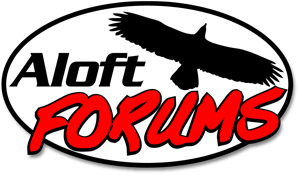Starting work on a new toy:

Yeah, I'm bit of a sucker for orange planes. We will be adding these to the site once we get some flight time with these. I guess you could say they are a bit of a hit with the crew as half of them have already taken one home for their own. Always a good sign.
Always a good sign.
After playing with a bunch of numbers I'm going to outfit mine with a light weight setup. A DYS Fire 2600kv motor:

 alofthobbies.com
alofthobbies.com
This is what I am looking at doing with it:

(I did not enter the aircraft weight for the calc above, so ignore the thrust to weight value.)
I might start of with the Emax Avon 2 bladed prop just to see what it does, they are an interesting prop, but not going to be as aggressive as the APC 6.5 pitch:

 alofthobbies.com
alofthobbies.com
Some KST X08 servos in the wings, and also for the elevator should do the trick.
I'm building up the glass version as this one had a little shipping damage to it. The guys all grabbed carbon versions, and the carbon does have a stiffer wing. I think the lighter weight of the glass version and the lightweight quad motor will be a good mix.
Wingspan is 1 meter. Looks like you could fit a 5S pack in there pretty easy, or do a custom 6S split back without much effort.
Hope to get some work in on it tonight.
Yeah, I'm bit of a sucker for orange planes. We will be adding these to the site once we get some flight time with these. I guess you could say they are a bit of a hit with the crew as half of them have already taken one home for their own.
After playing with a bunch of numbers I'm going to outfit mine with a light weight setup. A DYS Fire 2600kv motor:

DYS Fire Motor
The FIRE series motors from DYS.Utilizing N54SH magnets and .1mm stator laminations, ISC Ball Bearings and 5mm hollow shaft, DYS has designed a motor that achieves smooth running and very respectable thrust numbers. More importantly, they fly really well.
This is what I am looking at doing with it:
(I did not enter the aircraft weight for the calc above, so ignore the thrust to weight value.)
I might start of with the Emax Avon 2 bladed prop just to see what it does, they are an interesting prop, but not going to be as aggressive as the APC 6.5 pitch:

Avan Performance Propellers
Hmm,,, these look suspiciously like the excellent, most groovy, propellers from Racecraft; Oh yea,, thats because the Avans were designed by guru prop designer Sage Thayer who also designed for Racecraft as well as others. Sage designed the Avans to work
Some KST X08 servos in the wings, and also for the elevator should do the trick.
I'm building up the glass version as this one had a little shipping damage to it. The guys all grabbed carbon versions, and the carbon does have a stiffer wing. I think the lighter weight of the glass version and the lightweight quad motor will be a good mix.
Wingspan is 1 meter. Looks like you could fit a 5S pack in there pretty easy, or do a custom 6S split back without much effort.
Hope to get some work in on it tonight.

